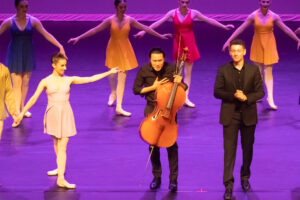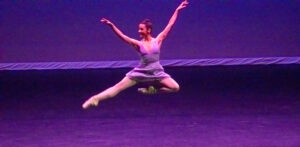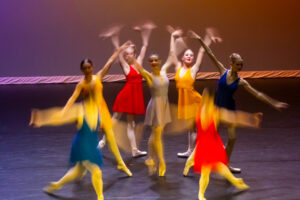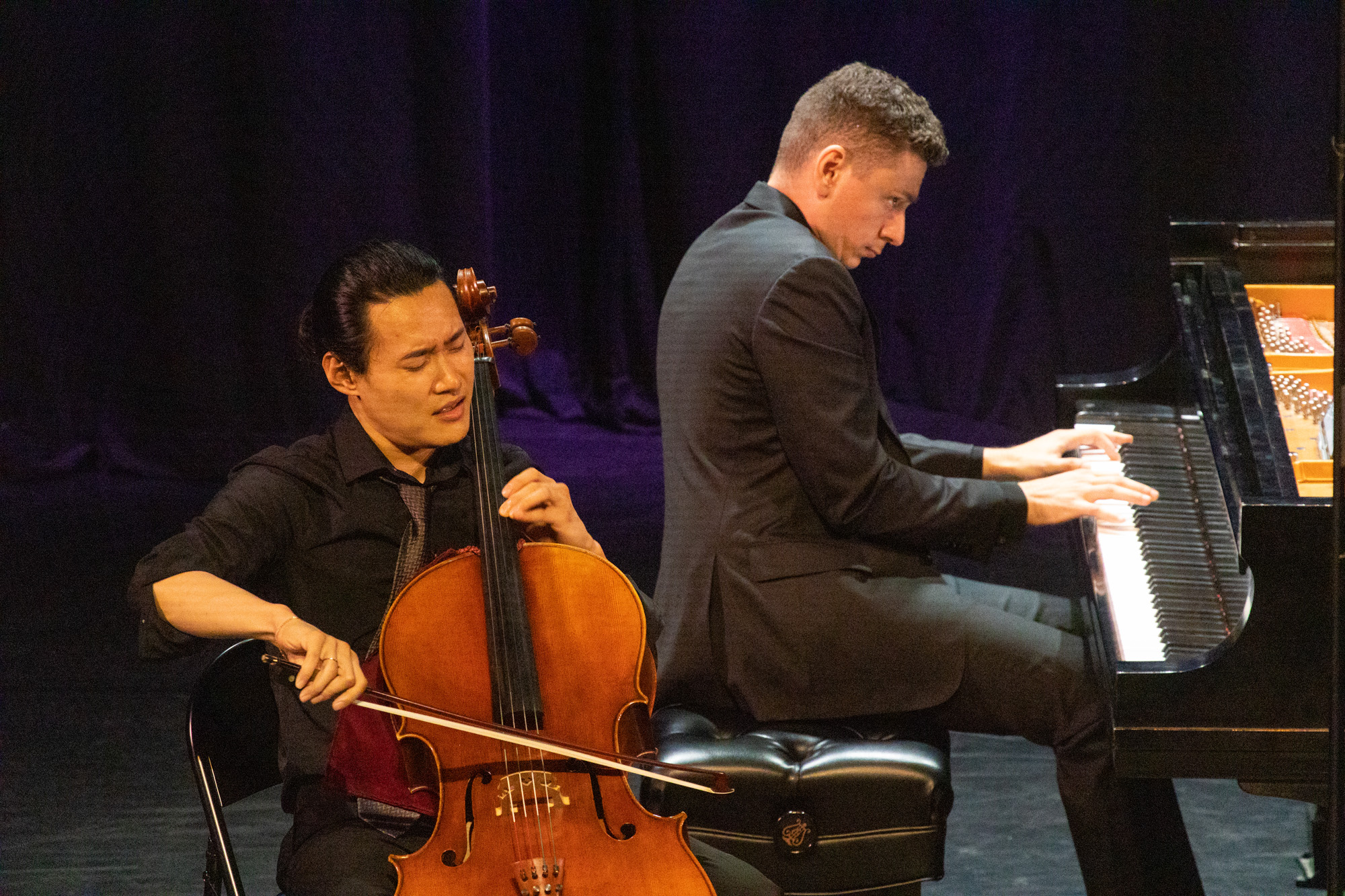Photos by Brian Lawler
The event reviewed here has ended, but please continue reading. To support current and upcoming events, visit the organization’s website for more information.
In the distant past, creative artists invented new genres that were comprised of several art forms simultaneously, such as the masques of Henry Purcell or the Gesamtkunstwerk operas of Richard Wagner. To that impressive list we could add the collaboration that took place this past Sunday, October 2, Songs That Make Us Dance, featuring superstar cellist Jonah Kim with his equally-talented pianist, Dominic Cheli—two of the most enthralling musicians that I have ever heard.
I entered the Harold J. Miossi Cultural and Performing Arts Center at Cuesta College expecting to hear a wonderful “recital,” but what took place was considerably more, for it featured captivating live dance, color slides of exquisite paintings, and even explanatory banter by Maestro Kim—always clever, inviting, lucid, pedagogical, and sometimes hysterical. Festival Mozaic‘s 2022-23 Artist-in-Residence could be featured on The Moth on NPR.

The combined interactivity of these elements, each fascinating unto itself, was spiritually moving and immersive as live theater.
I will remember this concert fondly, long into the distant future.
The hall was sold out, partly due to the hard work of the Festival Mozaic staff—but due primarily to the reputation Jonah Kim has earned through his many appearances at the Festival Mozaic Summer Festival. He is adored, and it showed.
The repertoire was remarkably complete and satisfying, opening with Mendelssohn’s “Song Without Words” in an adaptation by Kim. The pianist undulated in waves in 6/8 time while the cello sang the soaring tune.
Next, we heard Grieg’s beloved cello sonata (Opus 36), with its variegated moods: passionate, delicate, march-like, serene, mysterious, sparkling, assertive, and broadly colored (due to the exploration of every register, every bowing effect, and the widest spectrum of dynamic contrast one could imagine). The rapid passage-work and bold fortes were thrilling, but I was most entranced by Kim’s and Cheli’s super-soft pianissimos. The second movement evaporated into an almost inaudible mist, and phrase endings often had a “lift” that was truly enchanting.
The second half opened with San Francisco Ballet’s Wei Wang and Julia Rowe dancing to the musical strains of Dvořák’s “Silent Woods” played by Kim and Cheli. The combination was glorious; the subtle artistry of the two dancers matched the virtuosic craft of the two musicians, making one of the most enthralling quartets of any chamber concert I’ve ever attended.

As the second half unfolded, Kim and Cheli returned to their duet configuration and launched into one of Kim’s favorite pieces—Samuel Barber’s cello sonata. Every aspect of the cello (and keyboard) was presented to perfection and dramatic effect. For instance, there were often notes played in shimmering tremolo by Kim, but he did each one differently, sometimes vibrating the bow near the frog, at other times in the middle, and at other times, near the bow tip—each sounding different and colorful, and just three examples of the hundred colors that Kim painted.
The duo played with such intensity at the climax points that I could have sworn there were 20 musicians on stage, and at the moments of jaunty humor, their presentation was almost mirthful, contrasting dramatically with the more serious, melancholy moments. One laudatory aspect of their interpretation was the use of time: they took their time between the different mood swings so that the full musical flavor of each section could be savored. Magnificent musicianship.

Perhaps my favorite moments of the mesmerizing afternoon were the two world premieres that were to follow: Mark Abel’s “Approaching Autumn” and Sheridan Seyfried’s “Dancing in the Eye of the Storm.” Abel’s piece was as impressionist in color as the painting that was displayed over the stage. There were crisp snaps of the cello’s strings against the neck (what my orchestration prof called “Bartok pizzicato”), the glassy sound of ponticello, flickering tremolos, Bach-like counterpoint, and conversational interactions between the keyboard and cello.
Seyfried’s work was the audible incarnation of the THRILLING. Kim described the piece as “jumpin’,” and it truly was frenetic, jazzy, and jaunty. It is rare to hear two world premieres on the same concert, and rarer still to hear two works that deserve to become part of the standard repertoire. Abel and Seyfried are worthy companions to the other composers on this resplendent program.
And the final gem, the Kreisler Tambourin, was the visual and theatrical climax of the afternoon: the stage was filled with dancers from the Movement Arts Collective choreographed by Ryan Lawrence. We could have been at the New York City Ballet. I loved the symmetry: opening and closing with dance collaborations.
Truly, Festival Mozaic (and Kim and friends) presented us with a magical afternoon. Kudos.
Editor’s Note: Read Sandy Baer’s profile of cellist Jonah Kim, Festival Mozaic’s 2022-23 Artist-in-Residence.
